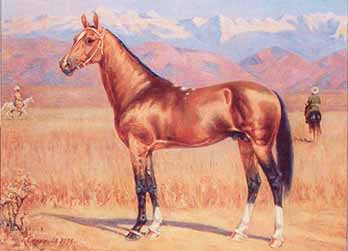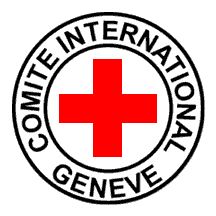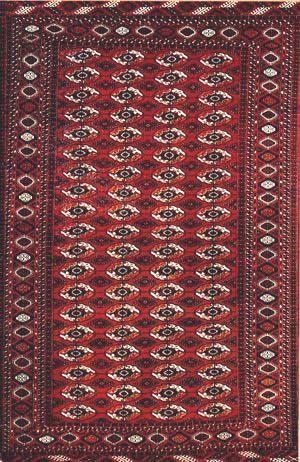Turkmen Akhal-Teke Horse
Topic: Turkmen Traditions

The Akhal-Teke horse breed (pronounced Ah-cull Tek-y) is a breed from Turkmenistan, where they are the national emblem. It is named after the nomadic tribe that bred them. They are racehorses, noted for their endurance on long marches and are thought to be the predecessors of the Arabian and English thoroughbred breeds. These beautiful "golden-horses' are adapted to severe climate conditions and are thought to be one of the oldest surviving horse breeds. There are currently about 3,500 Akhal-Tekes in the world, mostly in Turkmenistan and Russia, although they are also seen in Germany and the United States.
Alexander the Great's horse, Bucephalus, is said to have been an Akhal-Teke.
Breed characteristicsThe Akhal-Teke's most notable and defining characteristic is the natural metallic bloom of its coat. This is especially seen in the palominos and buckskins, as well as the lighter bays, although some horses "shimmer" more than others, and is thought to have been used as camouflage in the desert, where the heat causes the desrt to shimmer. Also noteworthy are the breed's almond-shaped eyes. The breed is very tough and resilient, due to the harshness of the Turkmenistan lands, living without much food or water. This has also made the horses good for sport. The breed has great endurance, shown in 1935 when a group of Turkmenian horsemen rode the 2500 mile journey from Ashgabat to Moscow, which lasted 84 days, and included a 3 day desert crossing of 235 miles without water.
The horses have a fine head with a straight or slightly convex profile, and long ears. The mane and tail is usually sparse. Their long back has little muscle, and is coupled to a flat croup and long, upright neck. The Akhal-Teke possesses a sloping shoulder and thin skin. These horses have strong, tough, but fine limbs, although the hind legs are sometimes sickle-hocked. They have a rather shallow body with a shallow ribcage (like an equine greyhound), although a deep chest, and this shallowness continues to the back of the frame. The conformation is not considered "good" by Western terms, but that is made up by the breed's great beauty, and tremendous athletic ability.
The Akhal-Tekes are brave riding horses, lively, and alert, but are known to be obstinant and rebellious at times. They are generally a one-rider horse.
The horses are usually a pale golden color (like honey) with black points. They can also be bay, black, chestnut, or gray. The Akhal-Teke usually stands between 14.3 and 15.2 hh.
Male horses are not gelded in Central Asia.
Breed historyAccording to some, the Akhal-Teke has been kept hidden by their tribesmen for years. The area where the breed first appeared, the Turkmenistan desert Kara Kum, is a rocky, flat desert surrounded by mountains. However, others claim that the horses were descendents of the mounts of Mongol raiders in the 13th and 14th century.
The breed is very similar to the Turkoman Horse, bred in neighboring Iran. Some historians believe the two are different strains of the same breed, and that the incredibly influential Arabian was developed out of this breed.
Tribesmen of Turkmenistan first used the horses for raids, feeding the animals grains and mutton. They selectively bred the horses, keeping records of the perdigrees orally. The horses were called "Argamaks" by the Russians, and were cherished by the nomads.
In 1881, Turkomenistan became part of the Russian Empire. The tribes fought with the tzar, eventually losing. A Russian general, Kuropatkin, who grew to love the horses he had seen while fighting the tribesmen, founded a breeding farm after the war and renamed the horses "Akhal-Tekes," after the Teke Turkmen tribe that lived near the Akhal oasis. The Russians printed the first studbook in 1941, which included 287 stallions and 468 mares.
The Akhal-Teke has had influence on many breeds, including the Thoroughbred through the Byerley Turk (which is thought to be Akhal-Teke), one of the foundation stallions of the breed. The Trakehner has also been influenced by the Akhal-Teke, most notably by the stallion Turkmen-Atti, as has the Russian breeds Don, Budyonny, Karabair, and Karabakh. The Arabian is also thought to have had an influence by the Akhal-Teke, most noteworthy being the Syrian Arabian.
The breed suffered greatly when the Soviet Union required horses to be slaughtered for meat, which however the local Turkmen refused to eat. At one point only 2,000 horses remained and export from the Soviet Union was banned. The government of Turkmenistan now uses the horses as diplomatic presents as well as auctioning a few to raise money for improved horse breeding programs.
In the early 20th century, crossing between the Thoroughbred and the Akhal-Teke took place, aiming to create a faster long-distance racehorse. However, the Anglo Akhal-Tekes were not as resilient as their Akhal-Teke ancestors, and many died due to the harsh conditions of Central Asia. The crossbreeding was ended in 1935, after the 2,600 mile endurance race from Ashkabad to Moscow, when the pure-breds finished in much better condition than the part-breds. The Thoroughbred cross is believed to have been so destructive to the breed that a horse with Thoroughbred ancestors must have 15 generations pass before it can be registered in the studbook. Since 1973, all foals must be blood-typed to be accepted in the stud book in order to protect the purity. A stallion not producing the right type of horse can be removed. The stud book was closed in 1975.
Uses of the Akhal-TekeBecause of the purity of the ancient breed, the Akhal-Teke is often used for developing new breeds. The Akhal-Teke, due to its natural athleticism, makes it a great sport horse, good at dressage, show jumping, eventing, racing, and endurance riding.
One such great sport horse was the Akhal-Teke stallion Absent, who won the individual gold medal at the 1960 Rome Olympics, at the young age of 8, under Sergei Filatov. He went again with Filatov to win the bronze individual medal in Tokyo in 1964, and won the Soviet team gold medal under Ivan Kalita at the 1968 Mexico Games.
Many Akhal-Tekes look like they move "above-the-bit," with the mouth about level with the rider's hands. This is mainly due to their upright necks.
Most Akhal-Tekes are found at the Tersk stud in the northern Caucasus Mountains.
Source: Wikipedia
Posted by countryturkmenistan
at 1:50 PM
 Ashgabat, 29 June 2005 (nCa) --- During a high level meeting Tuesday, Turkmenistan and the International Committee of the Red Cross (ICRC) agreed to deepen mutual cooperation.
Ashgabat, 29 June 2005 (nCa) --- During a high level meeting Tuesday, Turkmenistan and the International Committee of the Red Cross (ICRC) agreed to deepen mutual cooperation.
 The Akhal-Teke horse breed (pronounced Ah-cull Tek-y) is a breed from Turkmenistan, where they are the national emblem. It is named after the nomadic tribe that bred them. They are racehorses, noted for their endurance on long marches and are thought to be the predecessors of the Arabian and English thoroughbred breeds. These beautiful "golden-horses' are adapted to severe climate conditions and are thought to be one of the oldest surviving horse breeds. There are currently about 3,500 Akhal-Tekes in the world, mostly in Turkmenistan and Russia, although they are also seen in Germany and the United States.
The Akhal-Teke horse breed (pronounced Ah-cull Tek-y) is a breed from Turkmenistan, where they are the national emblem. It is named after the nomadic tribe that bred them. They are racehorses, noted for their endurance on long marches and are thought to be the predecessors of the Arabian and English thoroughbred breeds. These beautiful "golden-horses' are adapted to severe climate conditions and are thought to be one of the oldest surviving horse breeds. There are currently about 3,500 Akhal-Tekes in the world, mostly in Turkmenistan and Russia, although they are also seen in Germany and the United States. Turkmen arts and crafts witnessed uneven development of various specialties. They had high esthetic and technical qualities, especially among herders. This included embroidery of clothing, especially wool leggings - jorab, purses and carpets.
Turkmen arts and crafts witnessed uneven development of various specialties. They had high esthetic and technical qualities, especially among herders. This included embroidery of clothing, especially wool leggings - jorab, purses and carpets.